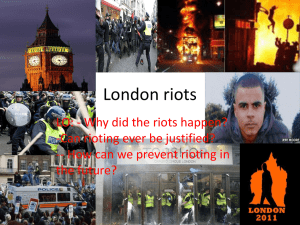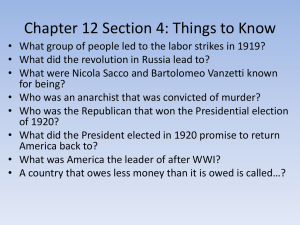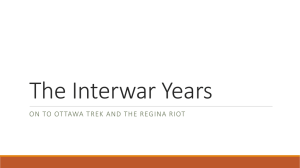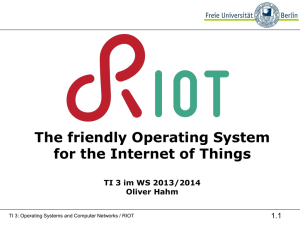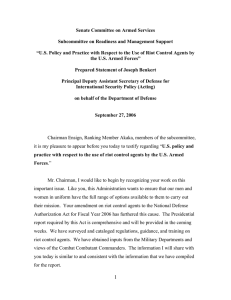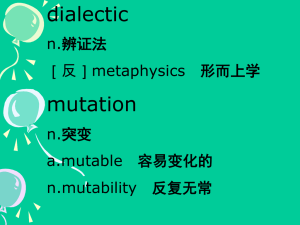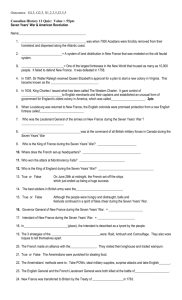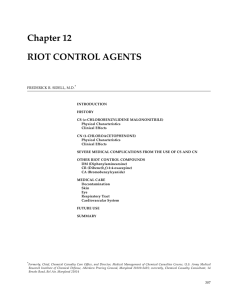Riot Jury Instruction definition Brief
advertisement
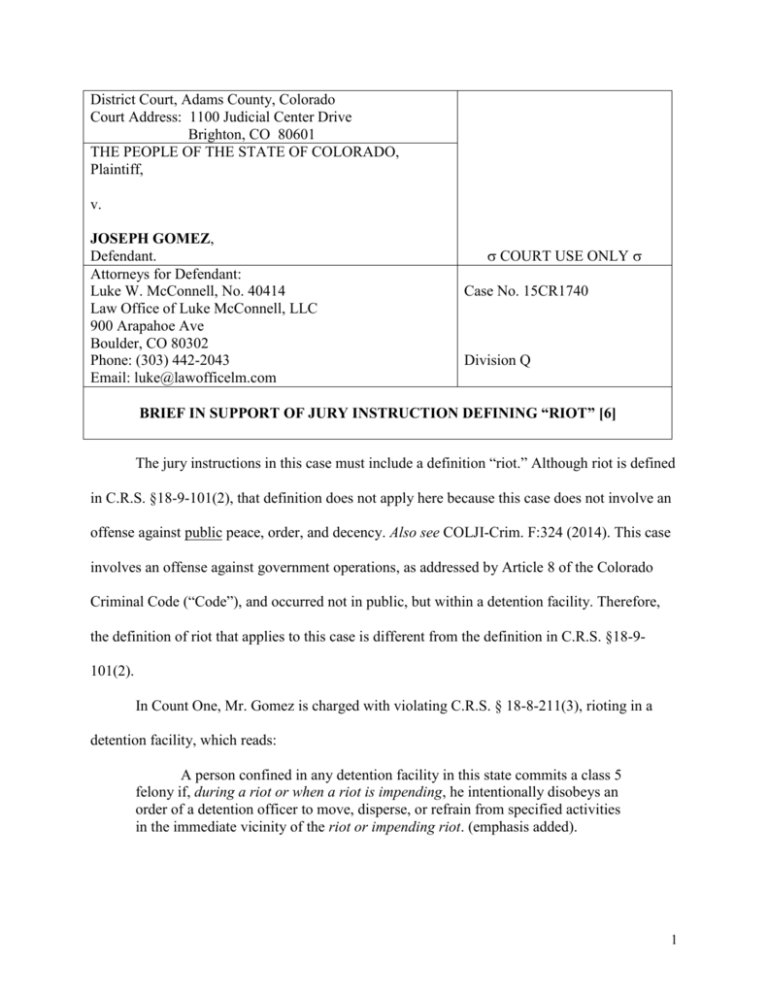
District Court, Adams County, Colorado Court Address: 1100 Judicial Center Drive Brighton, CO 80601 THE PEOPLE OF THE STATE OF COLORADO, Plaintiff, v. JOSEPH GOMEZ, Defendant. Attorneys for Defendant: Luke W. McConnell, No. 40414 Law Office of Luke McConnell, LLC 900 Arapahoe Ave Boulder, CO 80302 Phone: (303) 442-2043 Email: luke@lawofficelm.com COURT USE ONLY Case No. 15CR1740 Division Q BRIEF IN SUPPORT OF JURY INSTRUCTION DEFINING “RIOT” [6] The jury instructions in this case must include a definition “riot.” Although riot is defined in C.R.S. §18-9-101(2), that definition does not apply here because this case does not involve an offense against public peace, order, and decency. Also see COLJI-Crim. F:324 (2014). This case involves an offense against government operations, as addressed by Article 8 of the Colorado Criminal Code (“Code”), and occurred not in public, but within a detention facility. Therefore, the definition of riot that applies to this case is different from the definition in C.R.S. §18-9101(2). In Count One, Mr. Gomez is charged with violating C.R.S. § 18-8-211(3), rioting in a detention facility, which reads: A person confined in any detention facility in this state commits a class 5 felony if, during a riot or when a riot is impending, he intentionally disobeys an order of a detention officer to move, disperse, or refrain from specified activities in the immediate vicinity of the riot or impending riot. (emphasis added). 1 Riot is defined for purposes of Part 1 of Article 9 of the Code as: “Riot” means a public disturbance involving as assemblage of three or more persons which by tumultuous and violent conduct creates grave danger of damage or injury to property or persons or substantially obstructs the performance of any governmental function. (C.R.S. §18-9-101(2)) In People v. Lacallo, 338 P.3d 442 (Colo. App. 2014), the Colorado Court of Appeals addressed issues relevant to the definition of riot that should apply in this case. First, in the context of deciding whether to apply plain error review, the court observed that “[n]o Colorado case has interpreted the phrase “public disturbance” under section 18-9101(2). Nor do Colorado cases provide a commonly accepted definition for the term ‘public.’” Locallo at ¶29. The question of whether or not a “public disturbance” can occur within a detention facility was specifically not reached by the court in Locallo and remains an open question of law. See Locallo at ¶25. Of note, the attorney general argued in Locallo that the disturbance inside the jail was a public disturbance because it impacted members of the public who were visiting the jail and had to be evacuated. Id. Even accepting the attorney general’s expansive definition of what constitutes a public disturbance, no members of the public were affected by the alleged disturbance involved in this case. There is no “public disturbance” in this case because the events occurred inside the Adams County Detention Facility (ACDF). Moreover, the court in Locallo observed that none of the parties cited C.R.S. §18-1901(3)(n), which defines “public place” as “a place to which the public or a substantial number of the public has access, and includes but is not limited to highways, transportation facilities, schools, places of amusement, parks, playgrounds, and the common areas of public and private buildings and facilities.” Id. at ¶30. The interior housing pod where the events alleged in this case occurred is not a “public place.” Furthermore, unlike the definition of riot which appears 2 only in Part 1 of Article 9 of the Code, public place is defined in Article 1 of the Code, which is titled Provisions Applicable to Offenses Generally. Therefore the definition of riot contained in C.R.S. §18-9-101(2) applies only to the public offenses described in Article 9, and does not apply in this case. Second, the Locallo court held that engaging in a riot, as prohibited by C.R.S. §18-9-104, is not a lesser included offense of rioting in a detention facility as prohibited by C.R.S. §18-8211(1). Id. at ¶33-38. In reaching this conclusion, the Court drew a distinction between a public disturbance and one that occurs inside a detention facility. Id. Mr. Gomez is not charged with engaging in a riot as prohibited by C.R.S. §18-9-104. Not only does the definition in C.R.S. §18-9-101(2) specifically address only public disturbances, it involves conduct not proscribed by C.R.S. §18-8-211. “Tumultuous and violent conduct” is not contained in C.R.S. §18-8-211, nor is the obstruction of “any governmental function.” In contrast, C.R.S. §18-8-211 deals with only violent conduct in the performance of a riot and the obstruction of “the performance of institutional functions.” Furthermore, whereas §18-9-101(2) contains disjunctive language, §18-8-211 contains conjunctive language, which further evidences the different nature of the conduct meant to be proscribed. A riot as defined in §18-9-101(2) is “tumultuous and violent conduct” that either “creates grave danger of damage or injury to property or persons” OR “substantially obstructs the performance of any governmental function.” In contrast, §18-8-211 describes “violent conduct” that “creates grave danger of, or does cause, damage to property or injury to persons” AND “substantially obstructs the performance of institutional functions.” Although there are clear differences between the type of riotous conduct described in various statutes as outlined above, there is a common requirement that at least three people be 3 involved. Some statutes involving riots require even more than three people, but never less than three. See e.g. C.R.S. §18-9-102(1)(a). Based upon the language in §18-8-211(1), and the rationales above, the definition of riot that should apply in this case is: “Riot” means an assemblage of three or more persons inside a detention facility who engage in violent conduct that creates grave danger of, or does cause, damage to property or injury to persons and substantially obstructs the performance of institutional functions. This language tracks as closely as possible the language in C.R.S. §18-8-211(1), which provides the most guidance regarding the type of disturbance meant to be addressed by this statute. This definition is also not inconsistent with the other concepts of riot as separately and differently defined in Article 9 of the Code. Respectfully Submitted, /s/ Luke W. McConnell Luke W. McConnell, No. 40414 Law Office of Luke McConnell, LLC 900 Arapahoe Ave Boulder, CO 80302 Phone: (303) 442-2043 Dated: February 17, 2016 4 CERTIFICATE OF SERVICE I hereby certify that on this 18th day of December, 2015, a true and correct copy of the foregoing BRIEF IN SUPPORT OF JURY INSTRUCTION DEFINING “RIOT” [6] was served through ICCES to the following: District Attorney’s Office – 17th Judicial District 1000 Judicial Center Drive Brighton, CO 80601 /s/ Luke W. McConnell Luke W. McConnell 5
